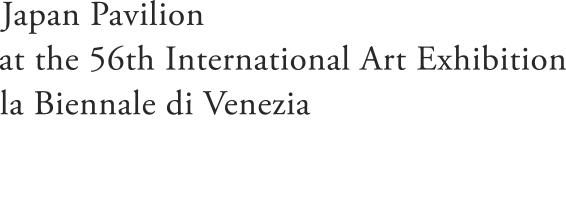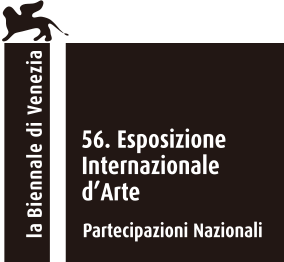Chiharu Shiota: "The Key in the Hand"
Hitoshi Nakano Curator, Kanagawa Arts Foundation
Berlin-resident artist Chiharu Shiota creates large-scale installations by stretching yarn across the exhibition space, and produces works out of materials that are filled with memories and traces of everyday life such as dresses, beds, shoes, and suitcases. She is notable for her skilled approach to the large installation format, which has become a special feature of the biennale in recent years. But Shiota’s choice of materials and the spatial structure of her installations maintains a sense of preeminent beauty without losing any freshness or power, quietly permeating our minds and bodies. Shiota’s work, which transcends linguistic, cultural, and historical contexts as well as political and social circumstances, and deeply affects viewers from all over the world, has been presented and esteemed in approximately 200 exhibitions in Japan and other countries throughout the West, Middle East, Oceania, and Asia.
After being confronted with the deaths of several intimate friends and family in recent years, Shiota has converted these experiences into the lingua franca of pure and sublime art without averting her eyes from the reality that all human beings must face “life” and “death” but that each of us must do so individually. At times, Shiota’s work conveys a sense of the “darkness” that is inevitably contained in the “unknown world” associated with death and uncertainty. Even today, four years after the Great East Japan Earthquake, it is conceivable that viewers from various countries visiting a large international exhibition like the Venice Biennale will be overwhelmed by the “dark” parts of her work due to its associations with a country that has suffered deep physical and spiritual wounds. In Shiota’s work, however, there is a powerful “light” of hope and spiritual brightness that dwells deep within the darkness. This is a light that is inherent not only in the tremendous anxiety that plagues Japanese people but in the precarious state of things all over the world.
In this exhibition, Shiota will integrate the gallery, located on what is essentially the second floor, and the outdoor pilotis on the first floor of the Japanese Pavilion. Upon entering the gallery, viewers will find a space filled with red yarn. Attached to the end of each piece of yarn, suspended from the ceiling, will be a key. In our daily lives, keys protect valuable things like our houses, assets, and personal safety, and we use them while embracing them in the warmth of our hands. By coming into contact with people’s warmth on a daily basis, the keys accumulate countless, multilayered memories that dwell within us. Then at a certain point we entrust the keys, packed with memories, to others who we trust to look after the things that are important to us. In this work, Shiota will incorporate keys as a medium that conveys our true feelings. Moreover, she will place two boats on the floor beneath the yarn and the hanging keys. The boats symbolize two hands catching a rain of memories (i.e., countless keys) pouring down from the ceiling. While struggling and working with the hands, the two boats will move forward through a huge sea of memory as they collect individual memories. Along with a large box located outside among the pilotis that will be used to display a photograph of a child holding a key in the palms of her hands, four monitors will show videos of small children talking about memories from before and immediately after they were born. By listening to them recounting memories from the time of their birth and looking at keys containing an accumulation of memories, we will experience two different phases of memory in the spaces. Prompted by the exhibition, we will discover memories contained within us, some of which will unfold and stay with us, and help us to form links with other people.
I look forward to watching as The Key in the Hand, an installation that forges a link between a space made up of keys, yarn, and two boats, and photographs and videos of children, transcends national, cultural, linguistic, and political contexts, and emotionally arouses countless visitors from all over the world.
About The Key in the Hand
by Chiharu Shiota
Interviewer - Helena Cassinello San Segundo
1. Now that we know what we can encounter when entering the Japan Pavilion at La Biennale di Venezia, could you explain the concept of The Key in the Hand?
Through my installation objects (the boat and the keys), my aim is to represent memories, opportunities and hope. The hanging old keys represent all these human conditions. They are held by a boat which symbolizes a hand wrapping and gathering each human being along with their important features. Visitors may feel as if walking around an ocean of memory. The keys are connected to each other by thousands of red strings. Keys are everyday objects that protect valuable things and by coming into contact with people’s warmth on a daily basis, the keys accumulate a web of memories that coexist within us. They are a medium that conveys our true feelings and they are connected to one another just as humans are. They even resemble the shape of a human body.
2. The pilotis are like a box holding the whole exhibition area above. What is the connection between the video of the children shown in the Japan Pavilion and the installation itself?
The videos show different children explaining their first newborn memory. It made me think that what the children were saying was a mix of fantasy and reality interpreted as the first memory of a human being. The pictures of children holding keys mean hope and opportunity. We are entitled to a world of opportunities and prosperous future and holding a key in our hands is the medium.
3. Once you come into the Japan Pavilion, the room seems to be shining a bright red light due to the red web of threads. Why do you use this colour?
I use red because it symbolizes the colour of blood and therefore human relationships connected to one another. When the red string inside a rope is visible, you can view the connection of society.
The red line is invisible to the human’s eye but it is strongly connected and once we are able to glance this piece of red thread, we can observe all relationships as a whole.
If an artist’s job is to affect the viewer emotionally, the yarn that controls their heart sometimes resembles words that express a connection between people. Relationships using knotted, tangled, cut, tied, or stretched yarn.
4. Where do the old hanging keys come from, and how many did you manage to collect?
In total I collected 180 000 keys and 400 km of red yarn. They come from all over the world. I put boxes in museums around the U.S.A, Japan and Europe but people donated their keys when I posted an advert in the Internet too. Some people wrote a letter explaining the meaning of their key and others came up to me directly to hand it in. I had been collecting them with great support since April last year.
5. The installation seems complex and I imagine much effort was put into building that web of red threads. How long did it take to build up the whole installation and how many people were involved?
It took me a year and a half to move from the idea to creating the installation. Building the space in the Pavilion took me two and a half months approximately and ten people working on it.
6. How did you feel when you were asked to represent the Japan Pavilion?
Showing my work at this International Art Exhibition had always been one of my dreams and it became true.
Over the years, all Japanese artists that had shown their work at La Biennale di Venezia Japan Pavilion were currently living in Japan, and by the time the curator asked me I had already been living in Germany for seventeen years. For this reason, it was an honor to be asked to take part this year.
7. As you say, you have been living in Germany for many years now and you are Japanese. How do you merge these two cultures and in what way does it influence your work?
Since I moved to Germany I have been meeting people from all over the world, so it was at that point when I began to be aware of my Japanese cultural background. Searching for this identity actually helps me create.
As a metaphor, if you put salt into a glass, pour water into it, and then leave it for a few days, the water evaporates and the salt remains. Long time after, the salt turns into crystal deposits. So when I lived in Japan, I felt like being inside that salted water and when I moved to Germany, everything became crystal clear. Since then I have gradually become stronger as an artist identity with a clear perspective.
8. As you mentioned before, the boats play an important role in your Pavilion. What do they exactly represent?
The boats symbolize two hands catching a rain of memories, opportunities and hope. They seem to be moving forward floating calmly along a huge sea of global and individual human memory.
9. The main concept of this 56th Biennale di Venezia set by its curator - Okwui Enwezor is “All the World’s Futures”. How did you engage this title with your work?
When you hold a key, you own new opportunites and therefore your own future.
The boats symbolize the hands holding 50 000 keys and each one has the shape of a human body. The upper part is the head, and the lower part, the body. Keys open and close doors to new chances. We are the guardians of our individual and global future and every human being has a place and a purpose in this World’s Future, whether it is to keep memories safe or to hope for a new beginning.
10. How did you get this idea for the Japan Pavilion? Where did you find inspiration for your work?
These past few years the Japan Pavilion presented works based on the earthquake and the Tsunami that followed, so I decided to convey not only past but also present and future. After facing the deaths of family members, the feeling of needing to keep something invaded me so I linked this feeling to all the possible meanings a key can have.
These boats carry and gather all those human features mentioned before that coexist on a daily basis within us and shape our own self. Humans are then connected to each other in this World by the red threads.





